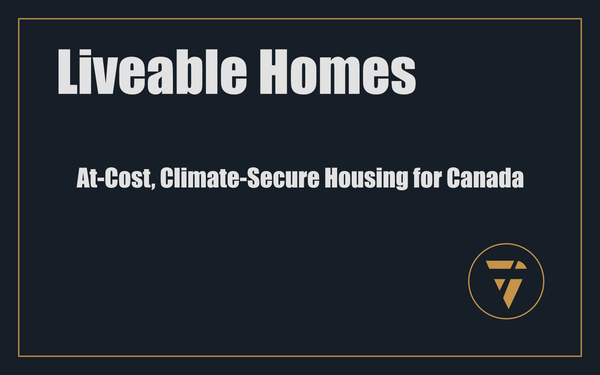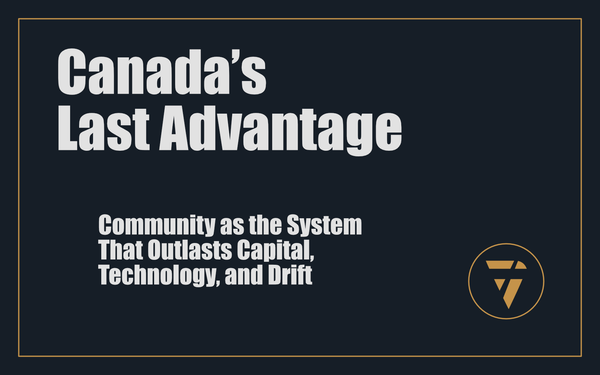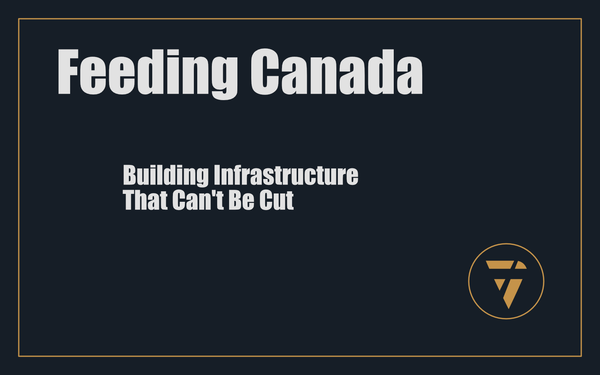The Retrofit That Reshapes a Nation

A Sovereign Arbitrage Hidden in Every Canadian Home
For all Canadians,
The Rot We Refuse To Measure
Canada doesn’t have an energy crisis.
We have an energy leak.
For decades, we’ve trained our eyes on the grid. We’ve measured demand. We’ve modelled supply. We’ve argued endlessly about pipelines, reactors, solar fields, and carbon capture.
And in doing so, we’ve ignored the largest energy asset Canada owns: the homes we live in.
16,900,000 of them. Most of them drafty. Inefficient. Costly to heat. Structurally outdated. Built by profit-motivated developers.
And leaking—day and night.
This is not anecdote. This is physics. This is the thermal reality of post-war Canadian housing stock.
No insulation standard. No performance target. No incentive to fix.
And no mechanism to recapture the waste.
There is zero incentive to build a quality home in today's market. Zero.
So we build more. More generation. More reactors. More wires.
More capital deployed to feed inefficiency.
That’s the rot.
We’re not solving the energy problem.
We’re subsidising its symptoms.
The Turn We Refuse to Consider
Now imagine this:
Every single-family home in Canada is retrofitted to meet Certified Passive House standards.
Every envelope sealed. Every system updated. Every structure optimised for thermal performance.
What happens?
Residential energy demand drops—by 90%.
Not theoretically. Not “up to.”
Certified. Measured. Verified.
And that single act—executed across the housing stock—eliminates the need for new baseload generation, for a generation.
No new plants. No new reactors.
No emissions gamble.
No taxpayer subsidy.
Just homes that work.
And a grid that breathes.
This is not a pipe dream. This is building science.
And we’ve had the standard for years.
The only thing missing is deployment.
The System We Refuse to Build
Here’s the model. And it’s critical you see it as a model—not a policy, not a program. A system.
- The government provides capital—not as a grant, but as a loan secured against the home.
- Homeowners opt into a national retrofit mandate—or enter upon sale, refinance, or renovation.
- Certified Passive House builders perform the work. Binary result. Pass/fail. No grey area. No inefficiency.
- The home’s operating cost drops. The market value rises. And the asset becomes yield-bearing.
- Upon resale, a portion of the gain is captured—tax, repayment, and performance yield—returning capital to the system.
The government’s cost? Zero net.
This is a self-replenishing fund.
The retrofit pays for itself.
And every home becomes a capital asset with sovereign yield.
This isn’t stimulus.
This is leverage.
This is vendor finance engineered into the housing economy.
The Numbers We Refuse to Run
Critics argue it’s too expensive.
Let’s walk through it.
- Average retrofit cost: $75,000–$150,000
- Total national capital required: $1.3–2.5 trillion
- Annual residential energy spend: over $40 billion
- Projected property value gain: 20–40%
- Government capital recovery via: lien, tax, gain-share
- Long-term public ROI: net-positive within 15 years
Compare that to a single nuclear reactor: $13–26 billion.
And a twenty-year build cycle.
And permanent operational risk.
And zero capital recovery.
Now repeat that nuclear build 10x—and you’re still not reaching the 90% demand reduction Passive House delivers.
The numbers don’t lie.
Only our framing does.
The Disruption We Must Demand
This isn’t tidy. This isn’t comfortable.
This disrupts everything.
Housing markets will shift.
Contracting supply chains will expand.
Utilities will lose demand.
Trades will be in shortage.
Municipalities will need retraining programs, zoning updates, inspection standards.
And that’s the point.
This is industrial mobilisation disguised as residential policy.
This is wartime economics, and we are, at war.
- We build retrofit academies in every region.
- We prioritise cold-climate zones.
- We target inefficient stock first.
- We certify contractors, verify output, tokenise results.
- We create a national registry of home performance, linked to the ledger, tracked in real time.
The retrofit isn’t the cost.
The retrofit is the economy.
The Future We Refuse to See
Every kilowatt not used is a kilowatt that doesn’t need to be generated.
That’s the principle.
And it holds more power than every turbine in the country.
By treating demand reduction as infrastructure—by making home efficiency a national asset class—we unlock a sovereign economic engine:
- We rebuild middle-class wealth, and ownership.
- We reduce emissions.
- We crush peak load.
- We turn homeownership into a yield instrument.
- And we build fiscal resilience into every block.
This is the financialisation of energy efficiency.
This is the monetisation of residential sovereignty.
And no other country has done it.
Because no one is willing to call it what it is.
A trillion-dollar arbitrage.
Hiding in plain sight.
The Table Is Set
To the Prime Minister.
To Mr. Carney.
To every policymaker, financial leader, contractor, and citizen:
You have the standard.
You have the science.
You have the math.
What you don’t have, yet, is the structure.
This is not another policy brief.
This is the answer.
If you want growth—build it here.
If you want revenue—back it here.
If you want climate victory—start here.
The greatest opportunity in Canadian economic history is sitting idle in your housing stock.
You don’t need a new plant.
You need a new premise.
Housing isn’t the problem.
It’s the lever.
Let’s move.
This is what I’m working on. Tell me what you think, I enjoy the conversation! Subscribe and follow the work in real time.
Thanks!
B

You don’t need a nuclear plant. You need a retrofit.
90% less energy. 40% more value. Zero public cost.
Housing isn’t the problem. It’s the lever.
PS -






